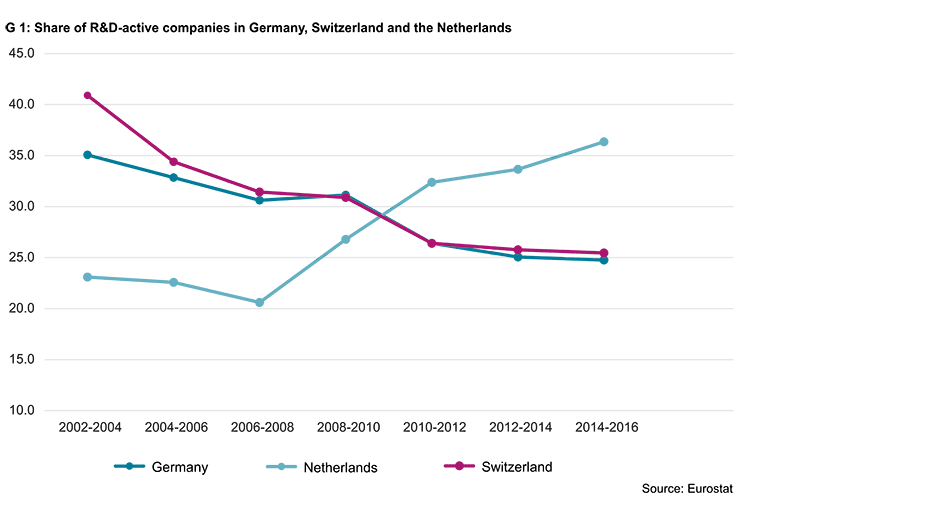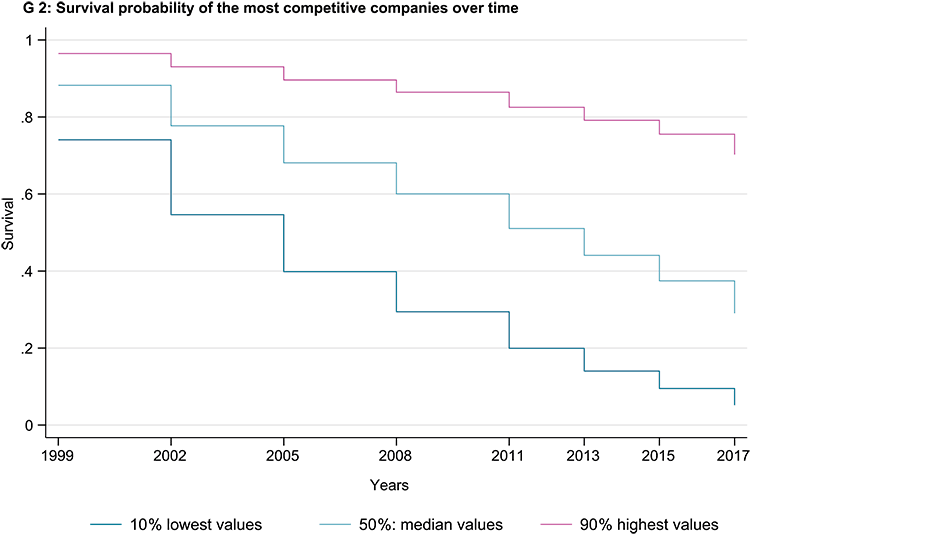What makes companies halt their research activities?
- Innovation
- KOF Bulletin
What sorts of firms have dropped out of R&D (research and development) and what consequences does this have for Switzerland’s economy? These questions are addressed both by the author and by the authors of the study ‘What Makes Firms Stop Doing R&D in Switzerland?’. This article focuses on the results of the first question: what types of companies have dropped out of R&D?

The proportion of firms engaging in R&D activities has changed greatly over time, not only in Switzerland but also in many other European countries. While a sharp decline in the share of R&D-active companies can be observed in Switzerland and Germany, this percentage is rising sharply in the Netherlands, for example (see Chart G 1).

By conducting a Survival Analysis, the authors of the study examine what types of companies have dropped out of R&D and what sorts of firms manage to carry out R&D over longer periods of time. The results show that a firm’s ability to conduct R&D over a lengthy period of time is characterised by several factors. The extent of a company’s previous innovation efforts and its competitiveness are the most important factors determining the probability of its own R&D activities surviving. While competitive firms had a 70 per cent probability of conducting R&D over the entire study period (1996 to 2017), this probability increases to 80 per cent if the firm is not only competitive but also among the top innovators1. In comparison, the probability of survival in the R&D market for less competitive and less innovative companies is around 10 per cent. Chart G 2 shows the probability of survival for the most competitive companies (values above the 90 per cent point2) over time. The probability of remaining active in R&D naturally decreases for these firms as well, but the decline is much smaller than it is for less competitive firms.

R&D is more profitable for large companies with international distribution channels and an extensive marketing department
Looking at the details, the size of a company is a key characteristic determining the probability of R&D activities surviving. Larger companies, for example, are more likely to have ‘complementary’ factors such as international distribution channels or extensive marketing departments, which increase the profitability of R&D activities and thus reduce the likelihood of exiting R&D. Having a well-educated workforce raises the likelihood of remaining R&D active by increasing a company’s capacity to learn and retain new knowledge. This makes it possible to identify external expertise relevant to innovation activities and to integrate it into innovation processes. Access to international markets (export operations) is also a crucial feature. R&D is expensive and incurs high fixed costs. Having access to large markets increases the commercialisation potential of the innovative product or service and thus the growth prospects of the company concerned. The fixed costs incurred are spread over a larger amount of output and therefore mitigate the risk of the R&D efforts’ commercial failure, which in turn significantly reduces the probability of the firm exiting its R&D activities.
A company’s technological potential indicates the level of technological expertise in the private and public domain worldwide that is available to the company to produce marketable innovations. A high level of technological potential means that the firm can draw on a large knowledge base (including basic research) in its R&D activities, which reduces the technological risk (feasibility) of R&D projects.
According to the analysis conducted, this feature also significantly increases the probability of R&D activities surviving. Finally, most of a company’s R&D expenditure is financed from its internal resources. The extent to which a firm’s operations are funded internally is closely related to its productivity. Because external investors are generally less inclined to finance risky R&D projects, it is much easier for more productive companies to fund their R&D activities. The Survival Analysis accordingly shows that high labour productivity is also a key characteristic of firms that invest in R&D over longer periods of time.
In contrast, the probability of dropping out of R&D activities is significantly higher if companies suffer from a lack of equity for their innovation operations or their innovative products can be copied too quickly and easily. This deprives innovative firms of their first-mover advantage and makes their innovation efforts less profitable.
Some productive companies do not need R&D at all
The company characteristics that are important for continuing R&D activities are the same characteristics that increase the likelihood of a firm entering R&D in the first place. However, there is an exception to this rule. Productive firms that do not engage in R&D have a significantly lower probability of entering R&D. One explanation for this finding is that they achieve excellent operating results outside these specific innovation markets and, therefore, there is no need for them to invest in risky R&D activities. Such companies can be found, for example, in the banking and insurance sectors and in the wholesale trade.
The findings relating to entering and exiting R&D activities suggest that the proportion of competitive and strong innovators in R&D markets has tended to increase. This raises the question of what this structural change means for productivity growth and the distribution of productivity gains. We will explore this question in the next issue of the KOF Bulletin.
--------------------------------------------------------------
1 These are companies that are among the 10 per cent of firms (90th percentile) with the highest values for these variables in terms of the share of turnover derived from R&D expenditure, from new innovative products and services, or from significantly modified products and services.
2 These are companies that are among the top 10 per cent in terms of the following variables: employment (size of firm), value added per employee (productivity), share of employees with a university education, proportion of employees with a level of education higher than a vocational apprenticeship (excluding university graduates), technological potential, and share of turnover generated by exports.
The full study entitled ‘What Makes Firms Stop Doing R&D in Switzerland?’ is available here.
Contacts
KOF Konjunkturforschungsstelle
Leonhardstrasse 21
8092
Zürich
Switzerland
KOF FB Innovationsökonomik
Leonhardstrasse 21
8092
Zürich
Switzerland
KOF Konjunkturforschungsstelle
Leonhardstrasse 21
8092
Zürich
Switzerland
Vrije Universität Amsterdam
Niederlande
